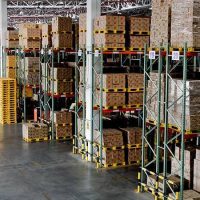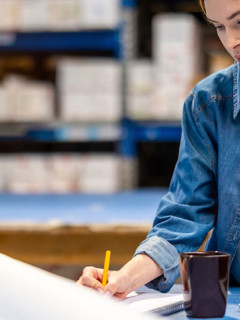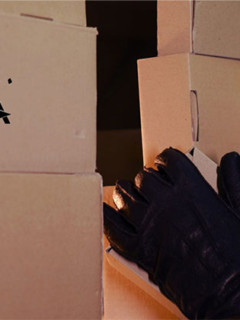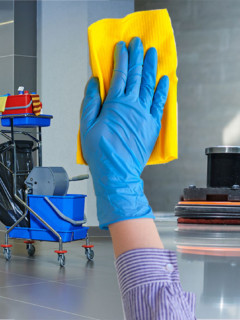Pallets are the ideal load carriers, several goods can be combined on it to form a loading unit. This means that several goods can be transported and stored in one piece.
Warehouses with a corresponding budget and a lot of space palletise their goods fully automatically. That makes sense – economically and ecologically. But not all companies can afford the necessary investments. In many companies, palletising is still done by hand: A laborious task that requires considerable physical effort and must be carried out with great care.
Loading pallets has to be learned
Loads always occur during transport, regardless of the transport route. When loading the pallet, it is therefore important to take into account the stresses that can occur during transport. Accordingly, the right packaging material and the right load carrier can be chosen (see also the article on the different types of pallets). A pallet that is only transported by lorry has completely different requirements to a pallet that is loaded from a lorry into a sea container or sent by air freight.
A pallet forms the load carrier, connected with the goods they become a loading unit. What is needed:
1. protect and seal the goods
The goods to be shipped should be well protected and packed as well as tightly closed. At this point, the choice of packaging material should already take into account which transport route will be used – road, rail, sea or air. Depending on the transport route, higher loads have to be withstood, which are decisive for the choice of the right packaging and the suitable filling and cushioning material.
Whether the pallet becomes resistant and stable stands (and falls!) with the use of the right cartons. If possible, palletisable cartons that are specifically tailored to the pallet format are the best choice.
Take into account:
- The maximum weight you want each of the boxes to carry and then choose the appropriate quality (1-wall, 2-wall…).
- The final size of your pallet to choose the size of the different boxes to be integrated into the pallet. This way you can limit empty space in or on the pallet – a cost-cutting factor, and at the same time a guarantee of stability!
2. load the pallet
In order to create an optimal loading unit, the pallet should always be loaded so that the packages fit on the pallet format. If there are any gaps, always move them inwards; the outer dimensions of the pallet should always be adhered to. Any gaps can be filled with spacers. If possible, avoid “column stacks”, as there is a great risk of the composite tipping over, which also means that the stability of the individual carton is lost, as the entire load is concentrated on the lowest carton when it tips over. When stacking boxes of different sizes, it is advisable to start with the smallest box and end with the largest box. In addition, store heavy cartons at the bottom and lighter cartons in the top layers of the pallet load. Composite stacking is always preferable as it makes the pallet more stable.
3. secure the pallet load
In order to increase the stability of the load on the pallet, for example Intermediate layers can be used to prevent individual layers of cardboard from sliding on the pallet. Edge protectors on the sides also prevent damage when loading the pallet and further strengthen the pallet load.
4. connect the load with the carrier
In order for the load to become a real load unit with the load carrier, they must be joined together. Strapping can be used to connect large cardboard boxes directly to the pallet. To avoid damage during tensioning, the edges of the load can be protected with Edge protectors can be protected. Stretch film additionally protects pallet loads from dust and dirt. If the load is stretched manually, the film really only serves as a protective barrier against dust and dirt. Only when stretch wrapping with a stretch wrapping machine can a sufficient securing force be achieved and the film is sufficiently bonded to the pallet. Pallets can also be secured using shrink film. However, the use of heat is always necessary here. Additionally protect Pallet protection films or protective tarpaulins, which protect the top of the pallet from the weather and dust after stretching.
Variants of strapping
When palletising, it is advisable to use strapping equipment to speed up the palletising process.
- With the manual tensioning and sealing device, pallets can be tensioned so that they do not open. We recommend the manual tensioner when very few pallets are in circulation daily, as it is not easy to operate.
- A manual hand strapping tool is interesting for warehouses that frequently palletise manually. It allows the operator to connect both ends of the strap and secure it with a strapping line. The semi-automatic strapping tool will interest those who palletise a lot and often, as it increases the speed of strapping.
Strapping
After strapping the pallet, stretch wrapping is the next step. There is a wide choice of stretch film, the following simple rules for manual palletising should be followed:
- The "normal Manual stretch film palletiser meets most companies' palletising requirements. It is quiet, resistant and transparent and is suitable for pallets of all sizes. Our cast film is a particularly environmentally friendly solution.
- A pre-stretch film can be a good idea when preparing medium-weight pallets with flat angles. Its big advantage? It is half the thickness and therefore allows effortless manual palletising.
- Unwinders allow you to stretch the pallets in a much more comfortable posture - while improving the end result!
5. mark pallet
Each pallet must be labelled with the address as well as the delivery note or other shipping documents, which are in Document pockets ideally protected. In addition, the load unit should be marked with appropriate warning labels according to the load. Pallet caps provide additional protection if the pallet is not allowed to be stacked.
Stacking protection with the pallet cap
Compared to the "DO NOT TOP LOAD" warning labels, the pallet caps have several advantages:
- They stand out better! Depending on where the warning notice is placed, it may actually be overlooked when manoeuvring in the warehouse.
- In addition to the visual warning, they also represent a physical inhibition threshold: While a sticker can gladly be "overlooked" once in a while, something is demonstrably destroyed when stacking pallets marked with cones - even hard-boiled space optimisers hesitate.
- After repeated reloading, the recipient does not necessarily know whether the pallet has actually covered the entire transport route without any "back luggage". The pallet is accepted and only after opening it does possible damage caused by loading become apparent. Annoying - and expensive, because once the acceptance has been acknowledged, improper handling during transport is virtually impossible to prove. In such a case, however, the destroyed pallet cap bears witness to the fact that the goods were loaded! If necessary, the recipient can check the goods carefully or reject them.
How the pallets can be moved safely and effectively within the company can be read in our Contribution to the topic of warehouse vehicles article.
In our webshop we have compiled products around the topic of Environmentally friendly palletising topic.















